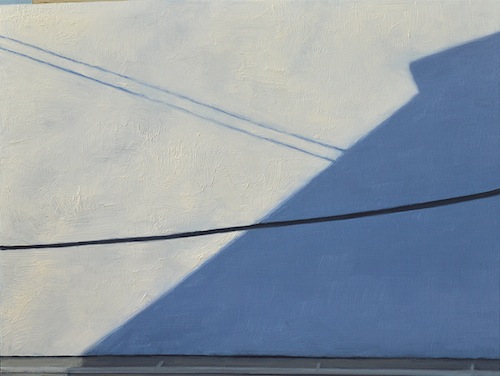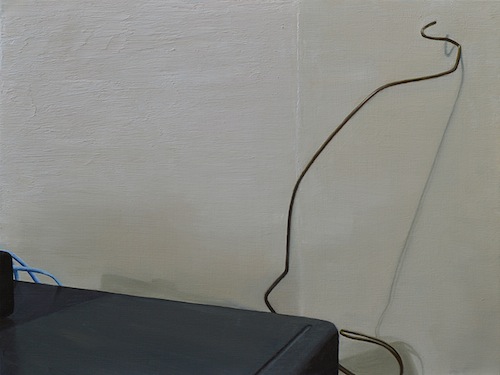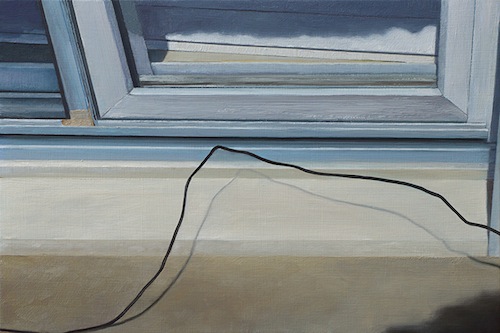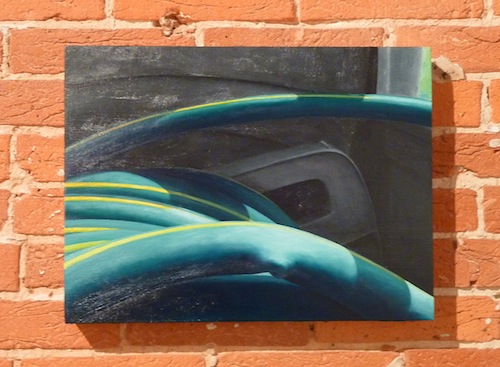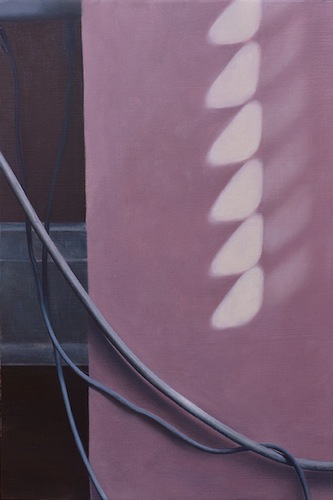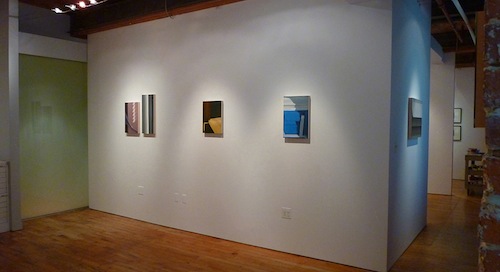“Movies are an empathy machine, drawing us into other lives, allowing us to identify with those of other races, genders, occupations, religions, income levels or times in history. Good films enlarge us, and are a civilizing medium. Bad films narrow us. No films at all impoverishes us.” – Roger Ebert
Lillian Bayley Hoover’s exhibition of recent paintings, “As It Is,” currently on view at Goya Contemporary, offers a humble, yet extraordinary collection of images. Over the past several years, the Trawick Award-winning artist has established herself as a reliable and thoughtful painter. While consistently strong, this work is different.
In the past, Hoover has used pictures to tell pointed stories, including imagery of significance, usually more literal than evocative. It often explored political criticism and propaganda. Earlier series were painted from dioramas and models, using cinematic staging to depict a sad, intimate and purposely false reality through a window of glossy oil paintings. Over time, the politics of the work became more personal, but at the same time, more distant in their staginess and the narratives became more mysterious. More recently, Hoover’s “Sites of Power” series sublimated a similar message. Through choosing to represent specific, but somewhat obscure international architectural locations, the paintings allowed the audience to appreciate the images separately from their content. Increasingly, Hoover’s paintings have created opportunities to take in their beauty without requiring recognition of politics or message.
All the while, Hoover’s paintings have existed in relation to each other in a way that evokes cinematic montage, using quick cuts of disconnected images, allowing the viewer to draw connections and fill in the gaps. This is a non-linear, editing-based and psychological way of telling a story. The relationship of painting to photography and film is complex, and yet unavoidably defines contemporary representational painting. How we read images, and how “painterly” a work is rendered; these are both terribly affected by an opposition of painting to the capture of image, digital or analog. Hoover is a painter and colorist of great skill and sensitivity, and here, as previously, she defines her compositions through photography. Beyond that, her paintings can be considered as images in sequence, telling a cumulative story through a series of juxtapositions related in theme.
With this newest series, Hoover removes herself almost completely from the comfort zone of “telling.” The images, in sequence and body, do not tell us anything. In opposition, the surfaces of the paintings now work ever harder to tell us what they are through textural subtleties, rather than to primarily render images. Surface detail and open context exist in these paintings in a way new to this artist.
The compositions in these paintings, compared to the preceding, are practically agoraphobic. The scope of subject has shifted drastically, as has the context. These paintings are of mundane and wholly domestic subjects. Shelves, stairs, window frames, baseboards and garden hoses; this is the stuff of suburban homeowners. However, the keen eye for color, composition and interest are as ever apparent in these new compositions despite being (seemingly) stripped of larger issues.
Only one painting hung in the gallery space falls out of line with this specific point of view – “Untitled (Hoses).” Here we are permitted to go outside. All other viewpoints are inevitably tied to looking inside or out of a house. Within this house, awkwardness prevails in Hoover’s compositions. The angles and viewpoints shown in these paintings find uniqueness in their strangeness and discomfort. The compositions ask the viewer to consider “from what position am I viewing this?” This sort of question continues the consideration of photography, as the viewpoints become increasingly uncomfortable. Under the table, zoomed into the window ledge, for instance. Was this painted from direct observation? Of course not. While it might be attractive to consider the genius artist who can sit, paint and control such a composition, that is not the point of this sort of painting anymore. These paintings attempt to freeze observed reality through photography, while rendering them in a magical way. Paintings like these are not a replication of photography, or reality, but an enhancement of such through the medium.
If there is a single painting and image that most embodies Hoover’s thoughts and process in these works, it is “Untitled (Cords).” The image is that of a wall, which functions as the primary ground for the composition, colored and painted as a nearly-disgusting “dusty rose.” Shadows and projections of light interact on the plane. Cords (recognizable as computer and/or monitor power cords, by their color and thickness) cast shadows upon the wall, hanging in a recognizable fashion. Balancing and defining the composition are striking soft triangles, read as vivid projections of light. The shapes imply that the light has been shaped and filtered through the mask of horizontal blinds. But while the light shapes are recognizable, they are not obvious.
There is something instantly recognizable about the image and situation, but at the same time, they are enigmatic in their awkwardness. Place yourself in this position. From what angle do we, any of us, view this? How strange is that viewpoint? The silly answer is – cleaning. These are the moments where we each have the opportunity to notice little shadows and refractions, and yet are rushed and so focused on the task-at-hand that they are missed. Which parts of this observation was intended by the artist? We can only pre-suppose, but it’s certain that Lillian Bayley Hoover has transitioned from telling to showing and allowing our own observations and experience to lead the way.
The way the work is presented in the viewing room at Goya Contemporary is, as always, considered and thoughtful. Despite this, I do wonder how a different arrangement would have changed how the images (only one element of the paintings) are read. On one hand, the most difficult aspect of the space is always the narrow corridor that leads from the main gallery into this smaller viewing space. It is an uncomfortable transition from the main gallery into the viewing room. Here, curator Amy Raehse takes advantage of that awkwardness by hanging one of the most uncomfortable and cramped compositions on the transitional wall. Physically, as visitors walk past the painting in a similar space to that of the compositional viewpoint in a pleasing moment of synchronicity. On the other hand, in the gallery itself, the paintings are arranged in pairs and in singles that direct the narrative between paintings more than I would have preferred.
The basic concept of film montage mentioned earlier is largely directed by the idea of pacing. In film, the duration of time a sequence or image lingers before a cut dictates this pacing, and also establishes priority. With these paintings, the layout and gaps between works function in a similar way – physical space and arrangement representing time. As hung in this space, the arrangement appears to be directed by scale and shape of painting, as well as color relationships from painting to painting. An alternative hanging with no pairings and each painting spaced more equitably could present a more open narrative, flattening the read of possible stories. As it is, the presentation is handsome. But these presentational choices limit the possibility to make different sorts of connections between paintings.
This writing began with a quote from the recently late film critic Roger Ebert. While a connection between Hoover’s use of images and film montage has already been offered, that is not the core of why the quote is included here. Ebert’s statement was specific to film, but can be easily applied to certain types of visual art. Which is to say, not all art seeks to create empathy. In fact, much contemporary art actively seeks to alienate or disregard their audience in the cause of challenge and relevance. Hoover’s work has always reached out to viewers, even pleading at times, but always with respect and a desire to connect. The work in “As It Is” creates charisma in its accessibility, transforming tiny moments into atmospheric short stories that tell us little, while offering plenty, within a specific domestic world that most can connect to.
“As It Is” is on-view at Goya Contemporary in the Mill Center at 3000 Chestnut Avenue in Hampden, Baltimore, MD through May 29. Hours: Tues-Fri 10am-6pm, Saturdays 12-5pm and by appointment.
Author Ian MacLean Davis is a Baltimore-based artist and instructor.
